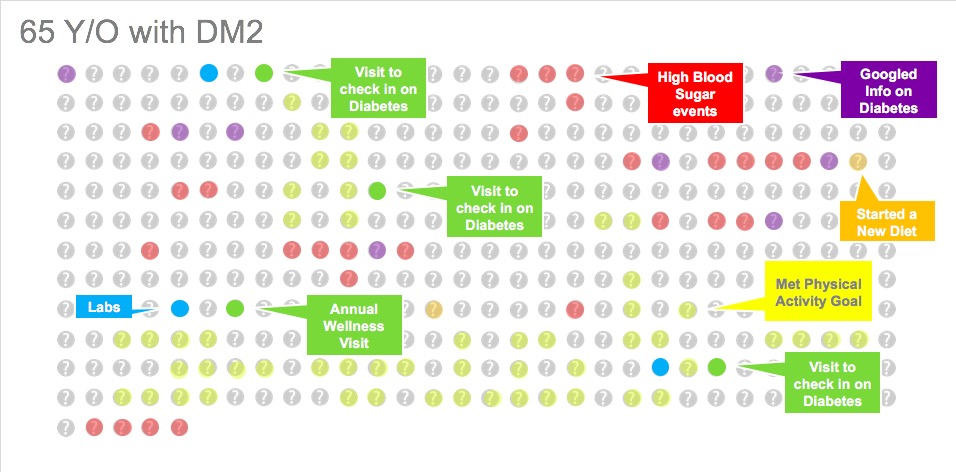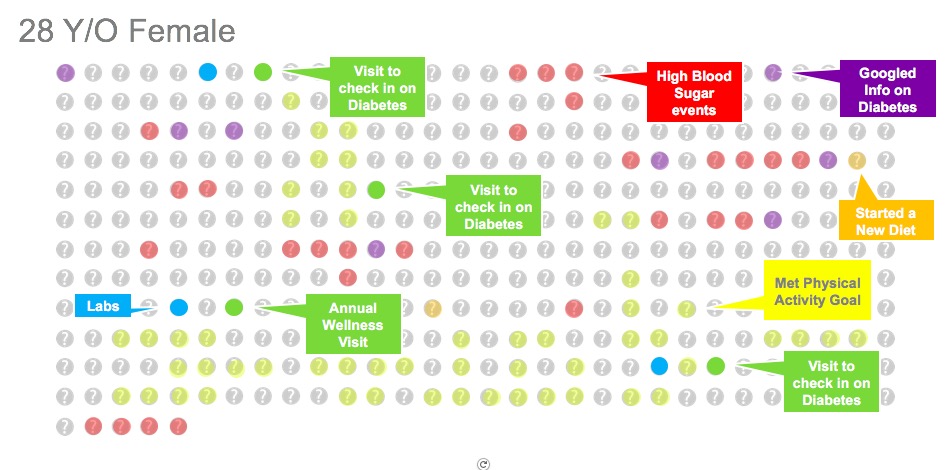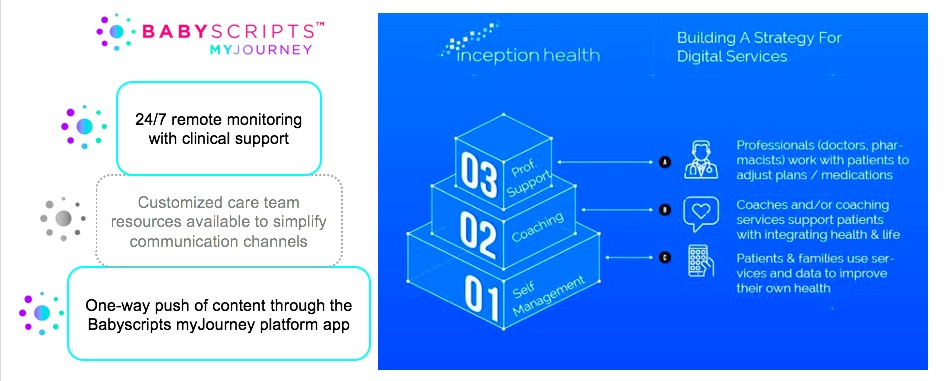Last week, we sat down with the team at Inception Health, the digital innovation arm of the Froedtert & The Medical College of Wisconsin health network. Michael Anderes, Chief Innovation and Digital Officer, Froedtert Health and President, Inception Health; and Kelly Stevenson, Senior Manager, Inception Health, shared how they approach innovation to ensure that new digital health solutions are impactful and sustainable.
The following is a transcript of the conversation that has been edited for length and clarity. Access the full webinar recording here.
Continuous virtual care is more than just a visit
Michael Andres: I want to start with the title of this talk, which refers to the transition from “the visit” to more continuous care. We, along with many other organizations, felt a pretty significant tail-wind with Covid, and as a result have been really scaling up digital efforts.
Yet many of the headlines and stats around healthcare during Covid over the last few months have been tied solely to visits— the media and many of the leading strategic organizations out there continue to be focused on the transition from the in-person visit to the virtual visit.
That’s all well and good, but it’s missing the huge potential impact of digital tools on healthcare.
If you keep thinking about visits alone, you’re going to be missing the bigger picture. Take one person — a healthy 35 year old, say. Each year in that healthy individual’s life represents 365 question marks in the healthcare system in any given year. The individual might have two intersections with the healthcare system — a check up, and maybe an appointment to diagnose and manage an infection. And those are all the data points we have about them.
In reality, this person might have had difficulty sleeping, they may have been googling information on depression or weight loss — there may be any number of health-related data points that occur in their life, but we as a health system have no visibility into that data.

Now take a more extreme example: a 65 year old with type 2 diabetes. This person will have more interaction with the healthcare system, maybe three or four visits. They’ll probably get some lab work done, maybe have a follow-up visit, probably attend an annual wellness appointment.
But this person has a lot more going on than can possibly be discussed during those visits. They most likely have had high blood sugar instances, they might have tried to self-manage their symptoms through Google or other resources. They may have started a new diet. If they were trying to manage their diabetes by some form of exercise, there were probably some days when they met that goal and some days when they didn’t.

All of these data points are occurring through the year, without provider visibility. And this picture is the more important picture — the space in between the intersections with the healthcare system.
Digital therapeutics to manage the spaces in between visits
We’ve insisted on a digital therapeutic to manage those spaces in-between: that is, software-based medical condition management.
The first example, the healthy individual who looks up his symptoms on the internet, he’s just the tip of the iceberg. There’s digital tools out there that can manage just about every condition imaginable.
Pop media and news has been picking up their interest in the space, and the money has been flowing in (more than $3B in the course of the last 6 years). There’s a ton of interest in this space from a public perspective and investment perspective.
As a health system we had to come up with a way to narrow down the options in digital tools. First, how does it deliver the support, and how supportive is it? For example, on the simplest end, you have chatbots and messaging interfaces; on the more complex end, virtual reality and app-based modalities with peripheral tools.
Next, what are these tools trying to accomplish? Some are purely self-help tools (with tracking and logs, for example). Others are more comprehensive, adding in a coaching element. At the highest end of comprehensiveness, these tools are actually aiding in medical decisions, in which case there needs to be FDA approval.
Given the options, we then needed to figure out how to use digital therapeutics to fill in those question marks between visits.
The Inception model
Our model starts with the least possible amount of intervention for the best possible outcome.

We start at the bottom of the pyramid with self-management, and if we can give a patient a tool that helps them to self-manage their condition and still get a good outcome then that’s all we need to do — we don’t need to give them something more comprehensive.
If we can’t give them that outcome, we have to look at the next level up, adding in coaching. If they’re still failing to meet outcomes, even with coaching, we add in clinical oversight and engagement and professional support.
We try to start every patient at level one and then move them up the pyramid based on their success.
From a diabetes perspective for example, we’d start with a self-management tool like mySugr, move to a tool with coaching like Omada, and then if we still aren’t getting the outcomes that we want, have a clinical care team managing them with the support of a tool like Glooko.
We had to figure out which tools could fit into this pyramid structure, and then also how to get it into the workflow.
(Digiceutical) formulary management
To do this, we took a page out of the pharmacy playbook. They have a formulary that determines some value about what the drugs are creating, and they put them into a formulary that allows those drugs to be prescribed.
Digital is a little more complicated — you have to figure out if the patient is eligible for digital health and if they are a good fit for a certain tool. Once they start to engage, you need to pull data to see how the individual is progressing.
What we did is partner with a company that builds a middleware that lives in the EMR. This middleware pulls up a recommendation list of digital tools for a particular patient, and the provider can then prescribe the digital tool right there from the EMR. The progress and the data and the dashboard from that tool are then viewable back in the EMR, so that the provider who prescribed the tool can see if the patient is using it, and if it has value.
These digital therapeutics are a necessary filler for visits — virtual or in-person, and may in some cases take away the need for the visit in the first place. However, a framework is necessary to help judge different options and figure out how to operationalize them in the workflow.
Incorporating Babyscripts into the formulary
Kelly Stevenson: Let’s take a test case of a 28 year old, healthy female who decides she’s ready to conceive and starts out on the pre-pregnancy, pregnancy journey. Historically, the health system view of this was centered on a rigorous 12-14 visit schedule after a pregnancy was reported by the patient.
This process starts with a call to report a suspected pregnancy. At the first appointment, the patient schedules out all her subsequent visits. She’s given a huge binder of educational information that she can reference throughout the pregnancy. Then she goes home, and several weeks that go by before she sees her doctor again.
The reality is that a lot happens in the in-between visit time — symptoms like nausea, elevated blood pressure, chronic headaches — and in many cases, the patient may take it upon herself to manage these problems on her own. She’s searching for guidance and advice in the days between visits — through Google, or through any number of consumer-facing pregnancy apps that exist out there for the public.

And this is a healthy patient. Imagine what this looks like for an unhealthy patient or a woman with co-morbidities (e.g., gestational diabetes, type 1 or type 2 diabetes, postpartum depression, trouble conceiving — the list goes on). There are any number of data points occurring in the space between those 12-14 visits.
Digital plays a pivotal role in engaging these patients across the data points and not just at the visit. These patients are often finding their own digital tools to consult, especially as women of childbearing age are a demographic highly engaged digitally and with their smartphones.
With a tool like Babyscripts, all of these data points can be pulled into one coherent solution, instead of being spread out across various digital gateways, and seen across the whole pregnancy. Plus, Babyscripts offers a way to get the care team involved.
Initial results of implementing Babyscripts
We introduced Babyscripts into our digital formulary for maternity care to address the self-management and professional support aspects of our platform. Through the Babyscripts app, educational and practice information is digitized and accessible in the palm of the patient’s hand, rather than counting on her to reference that packet/binder she received at her first appointment. It prevents the more likely scenario — that she looks the information up for herself instead of searching for that packet.

We incorporated Babyscripts into our formulary several months ago. It happened to coincide with the onset of the pandemic, but our plans to do this pre-dated Covid. Our goal with Babyscripts was to drive workflow efficiencies, and also enable appropriate connections and experiences so that Babyscripts could serve as a tool at the top of the pyramid effectively.
Integrating Babyscripts through the formulary allowed us to provide a valuable experience for the patient and our care teams. From the workflow perspective, it has enabled point of care ordering from within the medical record by anybody on the care team — it limits key strokes and reduces the errors of manual input, increasing our accuracy in delivering the invitation to the patient when they need it.
This integration has also enabled a more personalized patient experience. The invitation is white-labeled, so that the patient is assured of the reliability of its source, and it displays back the status of the patient in the EMR itself for the convenience of the provider.
From the monitoring perspective, data points collected from the patient are now visible in the medical record, which streamlines the process of accessing patient information.
And it’s not just beneficial for convenience — enabling these enhanced programs and communication has also resulted in better patient engagement and the means of measuring it. After deployment, we saw the average session per user increasing in the app, as well as increased compliance on the remote monitoring level, aided by the patient’s knowledge that the provider is looking at the data.
In sum, digital tools can play an influential role in moving from those point in time visits to continuous care. Turning these tools into a broad digital formulary, we’re able to extract additional value in economies of scale while enhancing both the patient experience and connection to the care team.
The recent Covid environment has only highlighted the importance of using digital tools as a normal part of our practice, but also that how they’re deployed systematically is very important in ensuring that they’re easily accessed.
Q&A
What has been your experience with provider acceptance of digital therapeutics?
MA: To put this in terms of the adoption curve, there were some early adopters, but the vast majority of providers weren’t completely clear on the “why” behind it. We started on this early — about 4 years ago — now we’re seeing adoption in the late majority. Without something like Covid at our back, accelerating adoption, we had to convince people that this new way of providing care was going to be important in the future.
KS: Introducing a level of consistency across digital tools has helped with adoption and decreased the friction of introducing a new workflow. Now that we’re beyond the early days of implementation, we’re able to introduce and scale tools more quickly.
What is the role of Inception Health with Froedtert & MCW?
MA: If you think it’s important to your strategy to bring the best of innovation from outside of your organization in, you have to figure out how you’re going to do that.
When we started this without Inception, we found that there’s a lot of standard reasons why [adoption of digital tools] gets slowed down. It came down to the big three: financial, legal, and IT. These three present barriers to innovation simply based on their structure.
Our view when we set up Inception Health as an innovation arm was to remove these frictions. We wanted outside innovators to want to work with us — we’re not the right size to be an accelerator, an exporter of innovation, but we did want to be an importer. We wanted to be known in the circles of U.S. digital health as a great place to go as a promising innovator to get a product quickly tested, embedded and scaled, because that’s what we built our engine to do.
To make sure that we weren’t overrun, we had to make sure that we had a filtering process on the front end. Working with partners at Avia and our own internal resources, we became the centerpiece of the organization, so that when a leader in the organization got a call from an innovator, they had a place to send those people to. We could perform a standardized vetting and make sure we would pick a solution that had long term viability.
Because we have a clinical arm, we’re different from a lot of innovation shops. That gives us more credibility in the organization, because we’re actually using the tools that we’re recommending.
Can you talk about provider fears around transitioning from the clinic to the home in terms of patient satisfaction?
KS: There was a big appetite to come out of the dark ages, with the maternity care population particularly — it’s a demographic that is very digitally engaged. Providers already knew that these patients were gathering info from their own sources from the questions they were bringing to the provider.
Being able to offer a tool that patients were seeking was a no-brainer. Of course you can’t force a digital tool on the patient — you need to make sure that you’re delivering care and engaging the patient in the way that they want to be engaged — and there is a process for determining whether a certain tool is right for the patient.
Obviously the status quo is to pull from the service line budget to invest in these solutions. Do you have other reimbursement solutions? Have you tried to get payer reimbursement for digital therapeutics?
MA: It’s a work in progress, but our initial thought was not to create any financial barriers — adoption was more important than getting paid. With the new codes that have come out for Medicare recently, there’s a number of tools that are being reimbursed now, and we also have a number of partnerships where either employers or payers are paying for these tools plus the clinical support behind them.
We’ve taken the approach of: if we charge, will it create a decline in those willing to pay for it? And if the answer is yes, we pay for it. If there’s an immediate and obvious value proposition, the patient may be willing to pay for it.
What digital programs are you looking to implement next?
MA: We tend to implement tools where we have a significant population that’s going to be affected by them — where a lot of lives are going to be improved. Those tend to be things that everyone is used to thinking of as large drivers of healthcare costs, like diabetes. Our view is that the medical conditions that exist for the majority of the population should have a corresponding digital therapeutics.
Any final thoughts?
KS: On the note of Babyscripts specifically, it was a tool that was a long time coming. I’ve managed other digital therapeutic integrations, and there was a lot less friction to deal with here. It partially comes from the patient’s desire to engage — the level of engagement that we see across this demographic compared to other tools is really exciting.
More generally, it’s a continuously evolving journey — with any therapeutic, you want to set it up so that it’s agile and you can pivot. There’s so much potential in this space, and we’re really excited to see where it’s going to go.
About Froedtert & the Medical College of Wisconsin Health Network

Submit a comment